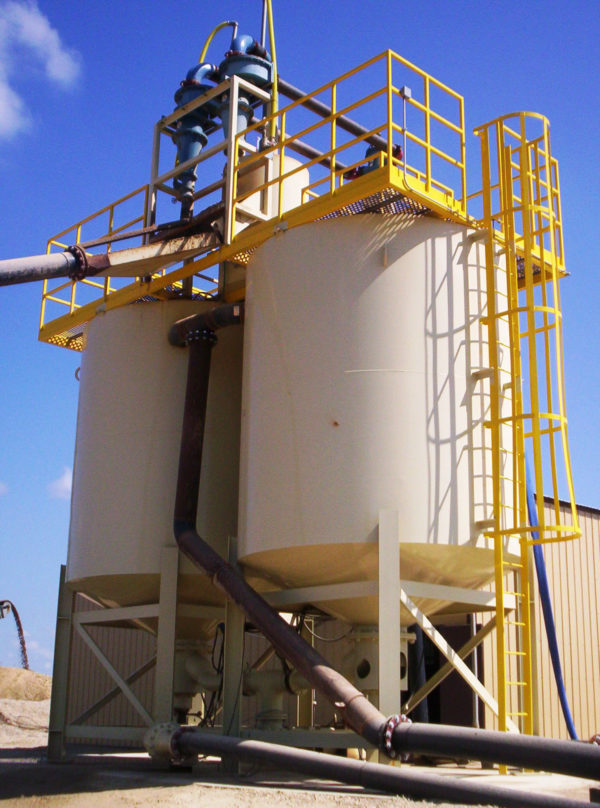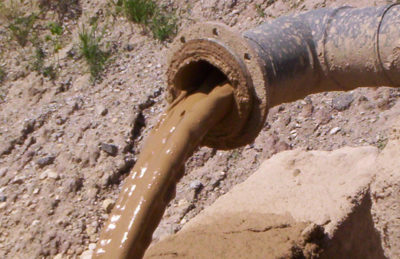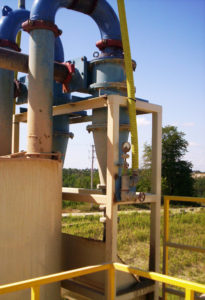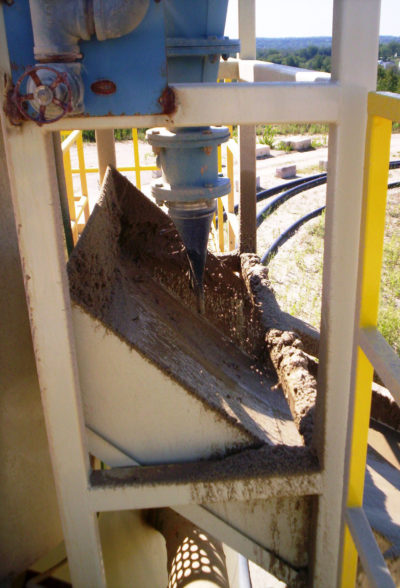Cleaning out the settling pond and hauling away the muck was a labor-intensive, season-long drain on the bottom line for Wissota Sand & Gravel – one that owner Christopher Larson was no longer willing to settle for. As such, Larson ultimately settled on “sustainability” with the installation of a stationary water clarification system that he says “has already paid for itself” by eliminating costly pond cleanout, and conserving valuable water and energy resources – capping the latter to a minuscule fraction of past levels. And, the positive environmental impact is a plus he is proud of. “It proves that we are a good, proactive producer – and a good neighbor,” he says.

Previously, Larson had a four-man crew, a backhoe with a bucket, and a haul truck dedicated to daily pond cleanout throughout each summer at his Richfield, Wisconsin-based site. “Only the top two feet of the pond would dry out with everything under that being ‘soup.’ The muck was nearly 70-percent water and when we tried to haul it out, it would come out the back end of the truck. It was just a mess,” he says.
Prior to the installation of a new wash plant several years ago, Larson knew that it was time to eliminate the labor and fuel costs associated with settling pond management. “Our new plant produces up to 800 tons per hour, so we knew we needed to clarify and clean the water coming off the plant, so that we could use it more rapidly and manage our fines more effectively,” he says.
Customized Clarification
Wissota Sand & Gravel installed a stationary water clarification system manufactured by Milwaukee-based Clearwater Industries, which provides turnkey solutions, site and water analysis, chemical selection and complete systems that are custom-designed for each specific sand and gravel application.
Clearwater Industries engineers a clarification system that allows operations to take a dirty water stream and produce clean water immediately, while concentrating the fines or solids to a thick state. To obtain a greater compression of mud and a drier consistency, the system features two tall, cylindrical aging tanks with internal mud rakes, combined with a dry polymer feed system, hydraulic package, control panel and mud discharge pump.
“We adapted our equipment to accommodate their existing cyclones, which are mounted on top of the clarifier,” says Bob Gralton, president of Clearwater Industries. Regarding a basic overview of the system, Gralton explains that the cyclones spin out the sand, or plus-200-mesh material. Water,containing fines, overflows the cyclones and enters the clarifier where it is treated with flocculants, forming solids which settle to the bottom. Clean water continually overflows the top of the clarifier and is recirculated back to the clear water pond that supplies the plant. Then the solids are pumped and discharged via a 10-inch pipeline to a pond where residual water weeps off the mud and runs into a low point. At the end of the season, the residual water is pumped back into the clean water pond, and the mud is used in reclamation.
a pond where residual water weeps off the mud and runs into a low point. At the end of the season, the residual water is pumped back into the clean water pond, and the mud is used in reclamation.
Clarification Payback
When Larson initially installed the system, he estimated an approximate 3.5 years for a complete return on investment. “But that was back when fuel was under two dollars a gallon, so the payback on this has accelerated rapidly,” he says, adding that, “There are operations out there who shy away from clarification due to the cost of flocculants – but you can buy a lot of flocculants for the cost of fuel.”
 Wissota is also realizing significant savings in water and electricity use. The plant is served by a 600-foot-deep, high-capacity well and a large industrial pump that had always been needed to replenish wash water used and the resulting water loss due to traditional settling pond management. “We used to run our well pump 24/7 all summer long to keep up with that water loss. Last season, with the use of the clarifier, we ran the well pump for a total of only 166 hours (approximately 7 days), which is a tremendous reduction in water and power resources,” says Larson.
Wissota is also realizing significant savings in water and electricity use. The plant is served by a 600-foot-deep, high-capacity well and a large industrial pump that had always been needed to replenish wash water used and the resulting water loss due to traditional settling pond management. “We used to run our well pump 24/7 all summer long to keep up with that water loss. Last season, with the use of the clarifier, we ran the well pump for a total of only 166 hours (approximately 7 days), which is a tremendous reduction in water and power resources,” says Larson.
Then there is the issue of improved product quality. “Consistently clean water means that it’s easier to remain in spec,” says Larson. Before the clarifier was installed, he stresses that even when constantly replenishing the water to the required levels, within a week the water would become cloudy, thus running the risk of fines contaminating the end product.
“Once you get past the learning curve, the system is very easy to operate. A computerized system handles flocculant injection, and all we have to do is keep an occasional eye on water levels, cleanliness and flocculant percentages. It’s pretty seamless,” says Larson.
curve, the system is very easy to operate. A computerized system handles flocculant injection, and all we have to do is keep an occasional eye on water levels, cleanliness and flocculant percentages. It’s pretty seamless,” says Larson.
Maintenance Ease
Once part of the settling pond cleanout crew, Plant Manager Daryl Schmidt worked with the Clearwater team to fine tune the clarification system during its first few months of operation. “I call it ‘Wissota-sizing.’ There are things we always like to tweak to make things easier to live with over the long term. But it’s a relatively maintenance-free machine, and it’s the ultimate machine to eliminate the labor and fuel costs of hauling that mud around. Now we just pump it where we want it to go and we’re done with it,” he says.
Schmidt remembers ponds from the past “that sat for two years and still looked the same as the day they were filled up. That’s how runny it was,” he says. Today, Schmidt points to a recently filled pond that is already solid. “This new clarification system is the only way to go,” he says, adding that the system will streamline future reclamation plans when mud will be pumped directly to additional remote locations, and will be used as a base under the top soil.

A Regional Leader
Established in 1916, Wissota Sand & Gravel is a successful third-generation, family-owned company which serves home builders, road builders, landscapers, developers – and “anyone else who needs quality sand and gravel,” says the company.
“We can bring more value to our customers and to our community by using systems that save on labor, fuel, water and power,” says Larson. “It’s funny, but when I first purchased the clarifier, the crew said ‘oh, no, what did you do now?’ But once we got it up and running, everybody said, ‘Why didn’t you put this in ten years ago?’”
As a regional leader, Wissota Sand & Gravel has certainly settled on sustainability.
As Seen In Aggregate Manager Magazine
Written By: Carol Wasson
Carol Wasson is a Fort Wayne, Ind. – based freelancer


